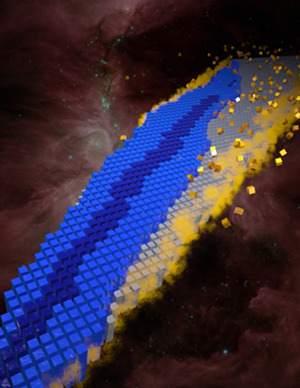
From left, Professor Yuri Efremenko of the University of Tennessee in Knoxville and Jason Newby of Oak Ridge National Laboratory are among 80 participants in COHERENT, a large, collaborative, particle physics experiment to record neutrinos at the Spallation Neutron Source. Photomultiplier tubes look like giant light bulbs and are used to detect light from neutrino interactions in detectors. COHERENT’s cesium iodide detector, the first to espy neutrinos at the SNS, employs a five-inch (13-centimeter) wide photomultiplier tube. An eight-inch (20-centimeter) wide photomultiplier (shown here) is deployed in COHERENT’s nearby liquid-argon detector. Measurements from different types of detectors are necessary for comprehensive studies of neutrinos at SNS. The scientists are standing in front of the cesium-iodide-detector shielding. (Image credit: Oak Ridge National Laboratory, U.S. Department of Energy; photographer Genevieve Martin)
By Dawn Levy/ORNL
After more than a year of operation at Oak Ridge National Laboratory, the COHERENT experiment, using the world’s smallest neutrino detector, has found a big fingerprint of the elusive, electrically neutral particles that interact only weakly with matter.
The research, performed at ORNL’s Spallation Neutron Source and published in the journal Science, provides compelling evidence for a neutrino interaction process predicted by theorists 43 years ago but never seen.
“The one-of-a-kind particle physics experiment at Oak Ridge National Laboratory was the first to measure coherent scattering of low-energy neutrinos off nuclei,” said ORNL physicist Jason Newby, technical coordinator and one of 11 ORNL participants in COHERENT, a collaboration of 80 researchers from 19 institutions and four nations.
The SNS produces neutrons for scientific research and also generates a high flux of neutrinos as a byproduct. Placing the detector at SNS a mere 65 feet (20 meters) from the neutrino source vastly improved the chances of interactions and allowed the researchers to decrease the detector’s weight to just 32 pounds (14.5 kilograms). In comparison, most neutrino detectors weigh thousands of tons: although they are continuously exposed to solar, terrestrial, and atmospheric neutrinos, they need to be massive because the interaction odds are more than 100 times lower than at SNS.
The scientists are the first to detect and characterize coherent elastic scattering of neutrinos off nuclei. This long-sought confirmation, predicted in the particle physics Standard Model, measures the process with enough precision to establish constraints on alternative theoretical models. [Read more…]

